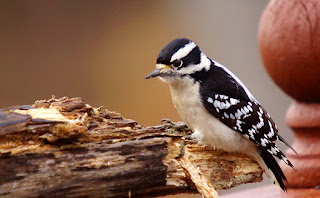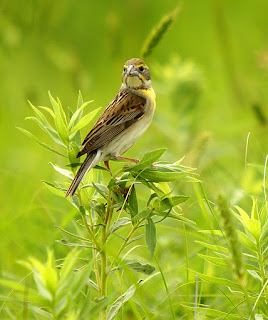About 35 or maybe 40 years ago I was out stomping around in an Oklahoma woods one day when a tiny bird fluttered into view. As often is the case, tiny birds like this one rarely linger very long before flittering off and so it was with this particular bird. Even though he was situated inside some heavy foliage, he did perch long enough and close enough for me to get a pretty good look at him and for the life of me, I could not identify what kind of bird he was. He was a medium greenish color, darker on top than on bottom, with a slight marking across his eye and white slashes across his wing and was maybe at most 4 inches or so long. On my way home I decided to find out what kind of bird it was.
 |
| Sissortailed Flycatcher - Oklahoma State Bird |
Of course back then there was no such thing as the internet, you had to manually look up stuff at the library or buy a book or something to help you find things. I was so intrigued by this strange looking little bird that I purchased a copy of A Guide to Field Identification of North American Birds. It's one of those Golden classic field guide books with all the great paintings of just about every bird that fly's across North America. I spent several hours thumbing through that book and never did positively identify that little bird. The best I could do was make an educated guess that he was some kind of Vireo. But which one?
 |
| Nuthatch |
It was the
which one question that launched me into the world of bird watching. For several years I kept a list going but discovered just how difficult it really was to distinguish between one type of bird and another who looked very similar. There were times I was sure I had identified a particular bird only to discover that particular bird didn't range in the area I found him and only existed far out west. I wasn't very good at the craft needless to say, at first anyway, but improved and learned a few tricks and things to help out. I'm still not very good at it, but even after all these years, I will make time to spy on our feathery little friends, mostly photographing them from time to time, but some time just watching them.
 |
| Purple Finch |
Kris and I both have been fascinated with a family of Robins who for several years have returned again and again to the same nesting location built in the fork of a little plum tree growing in front of our porch. We've seen several generations of Robins hatch, and grow, and fly off from that little nest. I'm gusessing of course that it is the same family, but I do believe it probably is as they seem rather protective of the location. If any other bird or Robin comes too close, well, they take a defensive posture and run them off.
 |
| Downy Woodpecker |
Bird watching sometimes comes across as a rather passive activity in which only old folks and mild mannered people participate. Contrary to popular belief, it is a difficult and challenging activity that requires much more than random luck to be successful. The birds are even more difficult to photograph. You must be detail oriented and look for those tiny differences that identify a bird, things like is there a ring around the eye, or a slash in front of or behind the eye? What about the wing markings or the tail markings? How large is the bird, what kind of beak does it have? How does it fly, flutter or straight. What song does it make? There are subtle color differences between two distinct species that look a lot alike. Does the bird even belong in this area? How about winter vs summer birds. These are just a few of the details you must become aware of when trying to identify birds.
 |
| Dicksisle - Tallgrass Prairie |
At one time, like most people every bird was a sparrow to me except of course the obvious ones like the cardinal, or blue jay or something. Every little brown bird I saw was a sparrow. I didn't realize just how many different kinds of sparrows there were, and not all brown birds were sparrows. When you look at sparrows more closely with the eye of a bird watcher, they become much more than the ordinary little brown bird. They have color and crowns, and topknots. They have white throats and rusty tops. They have face paint and speckled coats. Some are very dark while others are light in tone. When God said he had his eye on the sparrow, I believe I understand why now. They are fascinating birds.
 |
| Chickadee |
Bird watching can become one of the most satisfying of activities and one of the most frustrating of activities. Regardless, it is a challenge I really do enjoy. You do need a good pair of binoculars, a good field guide, and a willingness to give it a try. Photographing the birds is a natural extension of the bird watching mystic and maybe I will do an article on another time about bird photography.
Start your birdwatching activity in your backyard, or the local park, then branch out to other locations like a lake, or beach, or along a creek. The winter is actually a good time to go bird watching because the trees are bare and it simply makes it easier to see the birds.
 |
| Lark |
One thing I did is was to make some copies of a basic outline of a bird and carry them inside my field guide. When I see a bird, I do not trust my memory, so I will make notes on the outline extending the beak out to match what I see, or the tail markings and I also jot down things like how large the bird is and color markings I might see like the eye or across the back or head. With this information, I can then go back to my field guide and have a good idea of what I am looking for without having to rely on my memory. Some birds are kind of rare in a given area and that is when it becomes fun and necessary to record as many details as possible.
One day I would like to go on a canoe trip on the Bayou Deview in the Big Woods of Eastern Arkansas where tantilizing sightings of the thought to be extinct Ivory Billed Woodpecker have been made. It's the largest woodpecker in North America with the last known confirmed live sighting made in 1944. It is similar appearance to the more common Pileated Woodpecker, but significantly larger and with more white showing on its wings. What a thrill that would be to find one of those...but the odds of finding one are extremely thin, but making an effort to do so would be a tremendous challege.
 |
| Ivory Billed Woodpecker |
Kris and I this year have challenged ourselves to start a new bird list for 2018. I'm looking forward to adding to the list through the year. I still have that old bird field guide. It is dog-eared and the pages are coming apart, but it still serves the same pupose as it did 40 years ago when I bought it. I'm looking forward to the rewards, trials, and tribulations of once again seriously watching birds.














